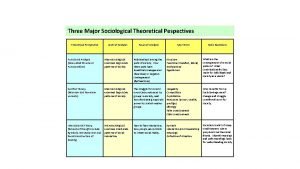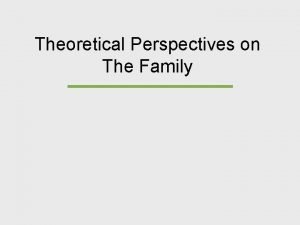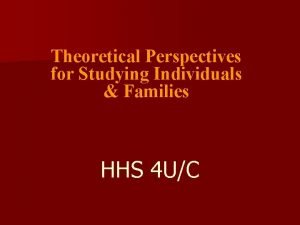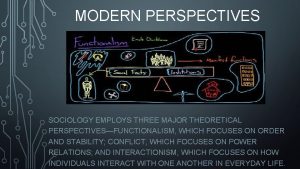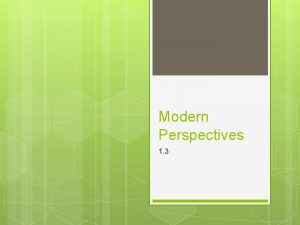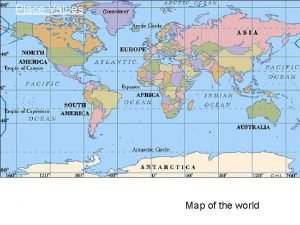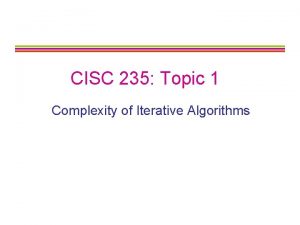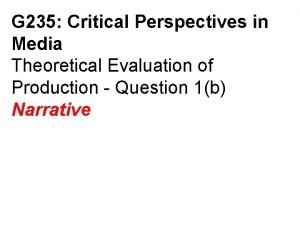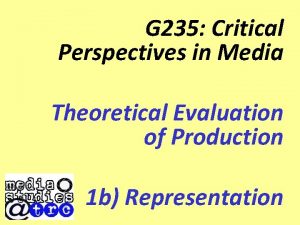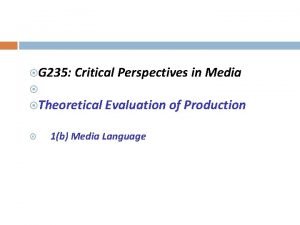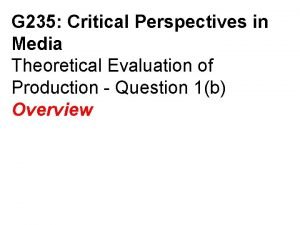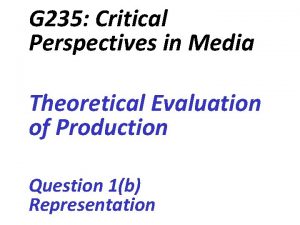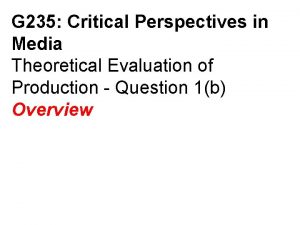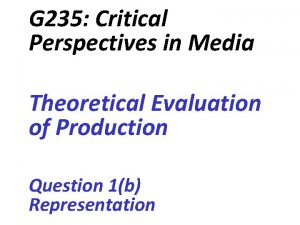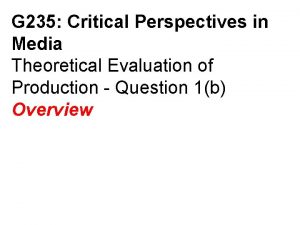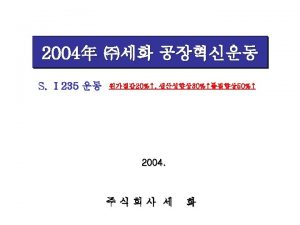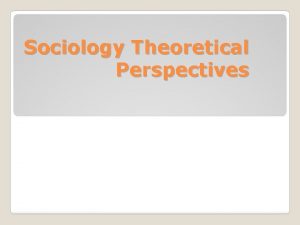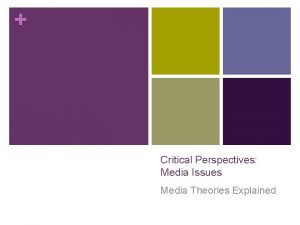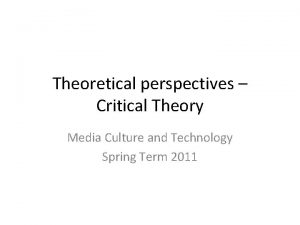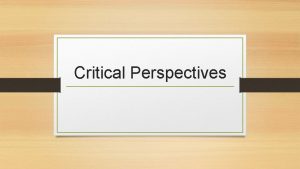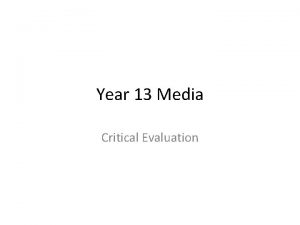G 235 Critical Perspectives in Media Theoretical Evaluation
















- Slides: 16

G 235: Critical Perspectives in Media Theoretical Evaluation of Production - Question 1(b) Narrative

NARRATIVE • TIM O’SULLIVAN (1998) ARGUES THAT ALL MEDIA TEXTS TELL US SOME KIND OF STORY. • MEDIA TEXTS OFFER A WAY OF TELLING STORIES ABOUT OURSELVES – NOT USUALLY OUR OWN PERSONAL STORIES, BUT THE STORY OF US AS A CULTURE OR SET OF CULTURES. • NARRATIVE THEORY SETS OUT TO SHOW THAT WE EXPERIENCE WHEN WE ‘READ’ A STORY IS TO UNDERSTAND A PARTICULAR SET OF CONSTRUCTIONS,

3 IMPORTANT WORDS… NARRATIVE: THE STRUCTURE OF A STORY. DIEGESIS: THE FICTIONAL SPACE AND TIME IMPLIED BY THE NARRATIVE – THE WORLD IN WHICH THE STORY TAKES PLACE. VERISIMILITUDE: LITERALLY – THE QUALITY OF APPEARING TO BE REAL OR TRUE. FOR A STORY TO ENGAGE US IT MUST APPEAR TO BE REAL TO US AS WE WATCH IT (THE DIEGETIC EFFECT). THE

The Structure Of The Classic Narrative According to Pam Cook (1985), the standard Hollywood narrative structure should have: 1. Linearity of cause and effect within an overall trajectory of enigma resolution. 2. A high degree of narrative closure. 3. A fictional world that contains verisimilitude especially governed by spatial and temporal coherence.

Tzvetan Todorov (1977) Bulgarian structural linguist. He was interested in the way language is ordered to infer particular meanings and has been very influential in the field of narrative theory.

Tzvetan Todorov 1. Stage 1: A point of stable equilibrium, where everything is satisfied, calm and normal. 2. Stage 2: This stability is disrupted by some kind of force, which creates a state of disequilibrium. 3. Stage 3: Recognition that a disruption has taken place. 4. Stage 4: It is only possible to re-create equilibrium through action directed against the disruption. 5. Stage 5: Restoration of a new state of equilibrium. The consequences of the reaction is to change the world of the narrative and/or the characters so that the final state of equilibrium in not the same as the initial state.

Roland Barthes (1977) Establishment of plot or theme. This is then followed by the development of the problem, an enigma, an increase in tension. Finally comes the resolution of the plot. Such narratives can be unambiguous and linear.

According to Kate Domaille (2001) every story ever told can be fitted into one of eight narrative types. Each of these narrative types has a source, an original story upon which the others are based. These stories are as follows: 1. Achilles: The fatal flaw that leads to the destruction of the previously flawless, or almost flawless, person, e. g. Superman, Fatal Attraction. 2. Candide: The indomitable hero who cannot be put down, e. g. Indiana Jones, James Bond, Rocky etc. 3. Cinderella: The dream comes true, e. g. Pretty Woman.

4. CIRCE: THE CHASE, THE SPIDER AND THE FLY, THE INNOCENT AND THE VICTIM E. G. THE TERMINATOR. 5. FAUST: SELLING YOUR SOUL TO THE DEVIL MAY BRING RICHES BUT EVENTUALLY YOUR SOUL BELONGS TO HIM, E. G. DEVIL’S ADVOCATE, WALL STREET. 6. ORPHEUS: THE LOSS OF SOMETHING PERSONAL, THE GIFT THAT IS TAKEN AWAY, THE TRAGEDY OF LOSS OR THE JOURNEY WHICH FOLLOWS THE LOSS, E. G. THE SIXTH SENSE, BORN ON THE FOURTH OF JULY. 7. ROMEO AND JULIET: THE LOVE STORY, E. G. TITANIC. 8. TRISTAN AND ISEULT: THE LOVE TRIANGLE.

The Russian theorist Vladimir Propp (1928) studied the narrative structure of Russian Folk Tales. Propp concluded that regardless of the individual differences in terms of plot, characters and settings, such narratives would share common structural features.

HE ALSO CONCLUDED THAT ALL THE CHARACTERS COULD BE RESOLVED INTO ONLY SEVEN CHARACTER TYPES IN THE 100 TALES HE ANALYZED: 1. THE VILLAIN — STRUGGLES AGAINST THE HERO. 2. THE DONOR — PREPARES THE HERO OR GIVES THE HERO SOME MAGICAL OBJECT. 3. THE (MAGICAL) HELPER — HELPS THE HERO IN THE QUEST. 4. THE PRINCESS AND HER FATHER — GIVES THE TASK TO THE HERO, IDENTIFIES THE FALSE HERO, MARRIES THE HERO, OFTEN SOUGHT FOR DURING THE NARRATIVE. PROPP NOTED THAT FUNCTIONALLY, THE PRINCESS AND THE FATHER CAN NOT BE CLEARLY DISTINGUISHED. 5. THE DISPATCHER — CHARACTER WHO MAKES THE LACK KNOWN AND SENDS THE HERO OFF. 6. THE HERO OR VICTIM/SEEKER HERO — REACTS TO THE DONOR, WEDS THE PRINCESS. 7. [FALSE HERO] — TAKES CREDIT FOR THE HERO’S ACTIONS

These structures are not unique to film but also advertising and news stories. In fact the structures presented are an integral part of the majority of both western and eastern cultures - details how narrative works in society to inform the audience of events, people, places through mediated ideologies within them. Narratives have a common structure!

JONATHAN CULLER (2001) DESCRIBES NARRATOLOGY AS COMPRISING MANY STRANDS “IMPLICITLY UNITED IN THE RECOGNITION THAT NARRATIVE THEORY REQUIRES A DISTINCTION BETWEEN STORY, A SEQUENCE OF ACTIONS OR EVENTS CONCEIVED AS INDEPENDENT OF THEIR MANIFESTATION IN DISCOURSE, AND DISCOURSE, THE DISCURSIVE PRESENTATION OR

CLAUDE LÈVI-STRAUSS (1958) HIS IDEAS ABOUT NARRATIVE AMOUNT TO THE FACT THAT HE BELIEVED ALL STORIES OPERATED TO CERTAIN CLEAR BINARY OPPOSITES E. G. GOOD VS. EVIL, BLACK VS. RICH VS. POOR ETC. THE IMPORTANCE OF WHITE, THESE IDEAS IS THAT ESSENTIALLY A COMPLICATED WORLD IS REDUCED TO A SIMPLE EITHER/OR STRUCTURE. THINGS ARE EITHER RIGHT OR WRONG, GOOD OR BAD. THERE IS NO IN BETWEEN. THIS STRUCTURE HAS IDEOLOGICAL IMPLICATIONS, IF, FOR EXAMPLE, YOU WANT TO SHOW THAT THE HERO WAS NOT WHOLLY CORRECT IN WHAT THEY DID, AND THE VILLAINS WEREN’T ALWAYS BAD.

Levi-Strauss also looked deeper into the way that narrative were arranged in terms of themes within that were ultimately always systematic oppositions. The order of events can be called the syntagmatic structure of a narrative, but Levi-Strauss was more concerned with the deeper of paradigmatic arrangement of themes. There is a choice of elements (paradigms) and they are arranged/dealt with in a particular way (syntagms).

THINK OF THIS QUESTION AS THE FIRST PART OF YOUR REVISION. . . “MEDIA TEXTS RELY ON CULTURAL EXPERIENCES IN ORDER FOR AUDIENCES TO EASILY MAKE SENSE OF NARRATIVES”. EXPLAIN HOW YOU USED CONVENTIONAL AND / OR EXPERIMENTAL NARRATIVE APPROACHES IN ONE OF YOUR PRODUCTION PIECES.
 Critical semi critical and non critical instruments
Critical semi critical and non critical instruments Semi critical
Semi critical Two sociological theoretical perspective? *
Two sociological theoretical perspective? * Theoretical perspectives on the family
Theoretical perspectives on the family Four theoretical perspectives
Four theoretical perspectives Three major theoretical perspectives in sociology
Three major theoretical perspectives in sociology Three theoretical perspectives
Three theoretical perspectives Load density in hashing
Load density in hashing Alpha beta gamma neutron
Alpha beta gamma neutron Round off to the nearest ones place
Round off to the nearest ones place Pc 235
Pc 235 Add the place value of 3 in 235 to 150
Add the place value of 3 in 235 to 150 Cas cs 235
Cas cs 235 234 235
234 235 Place value map
Place value map Cisc 235
Cisc 235 Cps 235
Cps 235


